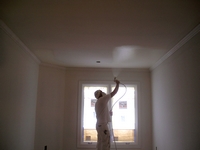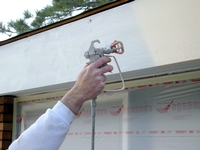Airless paint sprayers are one of the best inventions of all time. Only the brush and roller can be considered more important.
Airless sprayers can apply a wide range of coatings and finishes in less time than any other application method. Plus, apply the coating at any thickness desired.
The term airless sprayer refers to a method of applying house paint at high pressure to atomize the paint. This method works by forcing the paint, or primer, through a small tip opening at very high pressure. This produces a flat fan of the material being sprayed.
Airless Sprayers Don’t Use Compressed Air
The basic components of the airless paint sprayer are a pump, hose, gun and tip.
There are two pump types, piston and diaphragm. Both work very well. But the diaphragm type won’t be able to pump the very thick materials like a piston pump can.
The most versatile airless paint sprayers are the piston pump types.
A piston pump has many components including a piston, packings, and check valves. The piston moves up creating a vacuum to suck up the paint into a chamber, the fluid section, and down to push the paint into a high-pressure hose. The packings create a seal to prevent pressure losses during operation.
to suck up the paint into a chamber, the fluid section, and down to push the paint into a high-pressure hose. The packings create a seal to prevent pressure losses during operation.
Professional airless sprayers use self-adjusting packings to prevent premature wear and the need for repairs.
Check valves, or ball and seat valves, direct the flow of material from the fluid section of the pump to the hose. This prevents the paint from being pumped back through the pick-up tube.
All piston pumps have these components in one form or another.
A diaphragm pump also uses a piston, but in a different way. The piston moves hydraulic fluid to move the diaphragm, which in turn sucks up the paint and then pushes it through the hose and gun. No moving parts touch the diaphragm. The movement of the piston and hydraulic fluid cause the diaphragm to move up and down very rapidly.There are no packings with this design, but check valves are still necessary.
High-pressure hose is necessary for this application method.
This hose is rated for the maximum output pressure of the pump; 3000 psi is the typical operating pressure. The attached fittings are 1/4 inch and will work with most units. This is very tough hose that is kink resistant and capable of withstanding very high pressure.
Never attempt to repair this hose as personal injury could result. It is best to replace than repair.
The Airless Spray Gun
The spray gun is a valve that is used to control the airless paint sprayer and hold the tip. With a handle and trigger it resembles a handgun. When the trigger is pulled the valve is opened and paint is allowed to travel to the tip and finally to the surface being painted.
 Comfort is a big factor in choosing the right spray gun. Manufactures produce 2 and 4 finger guns. The numbers, 2 or 4, refers to the amount of fingers needed to pull the trigger. I like the 2 finger airless spray guns for their comfort and balance. Choosing a spray tip is difficult and depends on the capabilities of your pump and the material being sprayed. This choice will affect the performance and effectiveness of your airless paint sprayer.
Comfort is a big factor in choosing the right spray gun. Manufactures produce 2 and 4 finger guns. The numbers, 2 or 4, refers to the amount of fingers needed to pull the trigger. I like the 2 finger airless spray guns for their comfort and balance. Choosing a spray tip is difficult and depends on the capabilities of your pump and the material being sprayed. This choice will affect the performance and effectiveness of your airless paint sprayer.
These are the basic components of all airless paint sprayers. The type you choose to own will depend on your expectations and needs. Remember the thicker the material to be sprayed the more power you will need.
How Much Power Do You Need
The overall capabilities of an airless paint sprayer are dependent on the horse power, size of the piston and valve openings.
The piston and valve(s) is the fluid section which is connected to either an electric motor or gas engine. The bigger the pump the larger fluid section will be and the more horse power that is needed to work the pump.
All paint sprayers are rated as Gallons Per Minute (GPM) or Liters Per Minute. This is the measurement of flow through the pump and is a good indicator of a pumps capability. Another indicator is the maximum tip size supported.
It all comes down to, “What do you want to pump?”
- Up to .5gpm – Lacquer, varnish, typical house paints and solid color stain.
- .75-1gpm – Lacquer, varnish, typical house paints, solid color stain, some block fillers, smooth elastomeric, light mastic and epoxy.
- Over 1gpm – Typical house paints, solid color stain, block fillers, smooth and light textured elastomeric, mastic, dry fall and epoxy.


